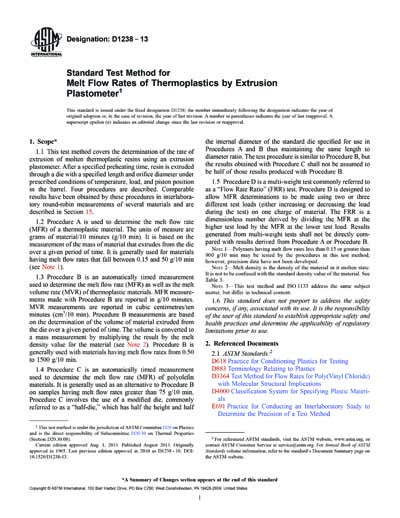Historical
ASTM D1238-13
Standard Test Method for Melt Flow Rates of Thermoplastics by Extrusion Plastometer
1.1 This test method covers the determination of the rate of extrusion of molten thermoplastic resins using an extrusion plastometer. After a specified preheating time, resin is extruded through a die with a specified length and orifice diameter under prescribed conditions of temperature, load, and piston position in the barrel. Four procedures are described. Comparable results have been obtained by these procedures in interlaboratory round-robin measurements of several materials and are described in Section 15.
1.2 Procedure A is used to determine the melt flow rate (MFR) of a thermoplastic material. The units of measure are grams of material/10 minutes (g/10 min). It is based on the measurement of the mass of material that extrudes from the die over a given period of time. It is generally used for materials having melt flow rates that fall between 0.15 and 50 g/10 min (see Note 1).
1.3 Procedure B is an automatically timed measurement used to determine the melt flow rate (MFR) as well as the melt volume rate (MVR) of thermoplastic materials. MFR measurements made with Procedure B are reported in g/10 minutes. MVR measurements are reported in cubic centimetres/ten minutes (cm3/10 min). Procedure B measurements are based on the determination of the volume of material extruded from the die over a given period of time. The volume is converted to a mass measurement by multiplying the result by the melt density value for the material (see Note 2). Procedure B is generally used with materials having melt flow rates from 0.50 to 1500 g/10 min.
1.4 Procedure C is an automatically timed measurement used to determine the melt flow rate (MFR) of polyolefin materials. It is generally used as an alternative to Procedure B on samples having melt flow rates greater than 75 g/10 min. Procedure C involves the use of a modified die, commonly referred to as a “half-die,” which has half the height and half the internal diameter of the standard die specified for use in Procedures A and B thus maintaining the same length to diameter ratio. The test procedure is similar to Procedure B, but the results obtained with Procedure C shall not be assumed to be half of those results produced with Procedure B.
1.5 Procedure D is a multi-weight test commonly referred to as a “Flow Rate Ratio” (FRR) test. Procedure D is designed to allow MFR determinations to be made using two or three different test loads (either increasing or decreasing the load during the test) on one charge of material. The FRR is a dimensionless number derived by dividing the MFR at the higher test load by the MFR at the lower test load. Results generated from multi-weight tests shall not be directly compared with results derived from Procedure A or Procedure B.
1.6 This standard does not purport to address the safety concerns, if any, associated with its use. It is the responsibility of the user of this standard to establish appropriate safety and health practices and determine the applicability of regulatory limitations prior to use.
ASTM International [astm]

